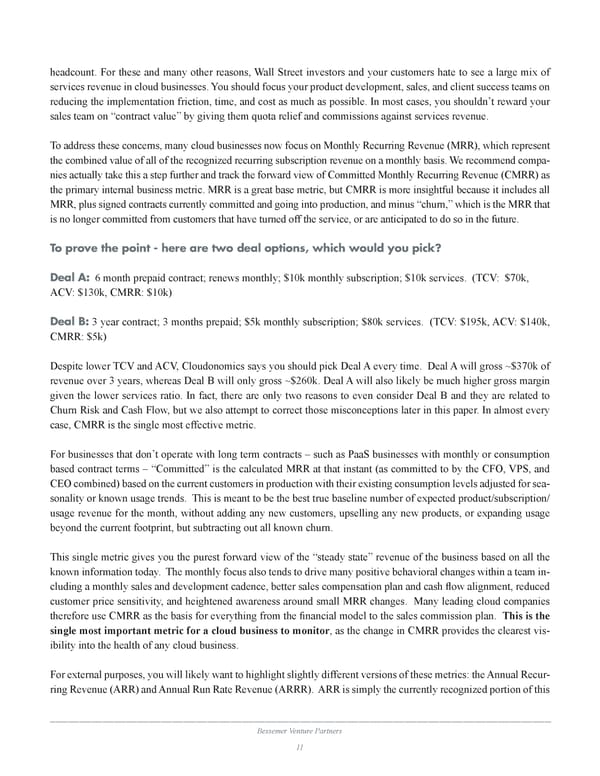headcount. For these and many other reasons, Wall Street investors and your customers hate to see a large mix of services revenue in cloud businesses. You should focus your product development, sales, and client success teams on reducing the implementation friction, time, and cost as much as possible. In most cases, you shouldn’t reward your sales team on “contract value” by giving them quota relief and commissions against services revenue. To address these concerns, many cloud businesses now focus on Monthly Recurring Revenue (MRR), which represent the combined value of all of the recognized recurring subscription revenue on a monthly basis. We recommend compa- nies actually take this a step further and track the forward view of Committed Monthly Recurring Revenue (CMRR) as the primary internal business metric. MRR is a great base metric, but CMRR is more insightful because it includes all MRR, plus signed contracts currently committed and going into production, and minus “churn,” which is the MRR that is no longer committed from customers that have turned off the service, or are anticipated to do so in the future. To prove the point - here are two deal options, which would you pick? Deal A: 6 month prepaid contract; renews monthly; $10k monthly subscription; $10k services. (TCV: $70k, ACV: $130k, CMRR: $10k) Deal B: 3 year contract; 3 months prepaid; $5k monthly subscription; $80k services. (TCV: $195k, ACV: $140k, CMRR: $5k) Despite lower TCV and ACV, Cloudonomics says you should pick Deal A every time. Deal A will gross ~$370k of revenue over 3 years, whereas Deal B will only gross ~$260k. Deal A will also likely be much higher gross margin given the lower services ratio. In fact, there are only two reasons to even consider Deal B and they are related to Churn Risk and Cash Flow, but we also attempt to correct those misconceptions later in this paper. In almost every case, CMRR is the single most effective metric. For businesses that don’t operate with long term contracts – such as PaaS businesses with monthly or consumption based contract terms – “Committed” is the calculated MRR at that instant (as committed to by the CFO, VPS, and CEO combined) based on the current customers in production with their existing consumption levels adjusted for sea- sonality or known usage trends. This is meant to be the best true baseline number of expected product/subscription/ usage revenue for the month, without adding any new customers, upselling any new products, or expanding usage beyond the current footprint, but subtracting out all known churn. This single metric gives you the purest forward view of the “steady state” revenue of the business based on all the known information today. The monthly focus also tends to drive many positive behavioral changes within a team in- cluding a monthly sales and development cadence, better sales compensation plan and cash flow alignment, reduced customer price sensitivity, and heightened awareness around small MRR changes. Many leading cloud companies therefore use CMRR as the basis for everything from the financial model to the sales commission plan. This is the single most important metric for a cloud business to monitor, as the change in CMRR provides the clearest vis- ibility into the health of any cloud business. For external purposes, you will likely want to highlight slightly different versions of these metrics: the Annual Recur- ring Revenue (ARR) and Annual Run Rate Revenue (ARRR). ARR is simply the currently recognized portion of this Bessemer Venture Partners 11
 Bessemer’s Top 10 Laws of Cloud Computing Page 10 Page 12
Bessemer’s Top 10 Laws of Cloud Computing Page 10 Page 12